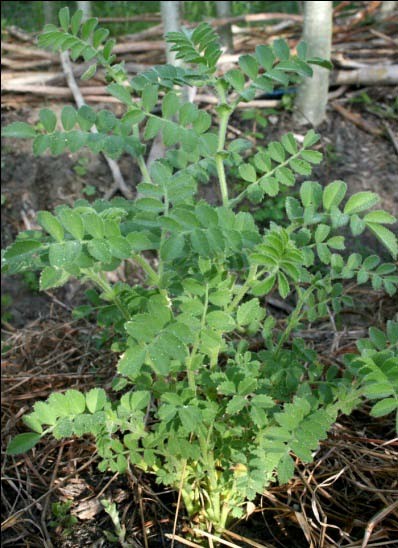
Looking for a nutritious legume that thrives in dry, cool conditions? You might want to try Cicer arietinum, referred to as chickpea and also by many other common names such as garbanzo, gram and bengal gram. Chickpea is noted for drought tolerance. It will produce a crop with an annual rainfall of 26-39 in (650-1000 mm), typical of semi-arid regions. Consequently, it has received attention as an alternative crop for areas where rainfall patterns have shifted to the extent that farmers cannot rely on the higher amounts of rainfall they would normally expect. Though often grown in more temperate areas, ECHO has chickpea seed from the International Center for Agricultural Research in Dry Areas (ICARDA), for evaluation in “southerly latitudes.”
Round-shaped pods are produced on short (usually 1-2 ft; 30-61 cm), bushy plants. Average yield of dried seeds, from pods typically harvested 90-150 days after planting, is about 700 kg/ha.
The green pods and young shoots can be consumed as a vegetable. Sprouted seeds can be eaten as a vegetable or added to salads. More commonly, the dry seeds are used to make flour or dahl. Dahl (split chickpeas without the seed coats) can be cooked to make a thick soup or dried and then ground into flour. The well-known paste called hummus is derived from a combination of cooked, ground up chickpea and sesame seed oil.
The seeds are high in protein (20%) and are a good source of potassium. In addition to use for human consumption, chickpea seeds can be milled for use as animal feed; animals can also eat the green or dried leaves and stems. As an animal feed, chickpeas have been shown to have similar nutrition as soya cake.
Chickpea’s origins are probably in southeast Turkey. The plant is grown in parts of Asia (e.g. India, Burma and Pakistan), areas of the Mediterranean, Ethiopia, parts of Latin America (e.g. Mexico, Argentina and Chile) and Australia. Chickpea prefers temperatures from 64-79°F (18-26°C), although more established plants can tolerate higher temperatures. Soil temperature should be above 59°F (15°C) for proper seed germination. Though drought resistant, chickpea is intolerant of heavy rainfall. Seed setting is optimal at a relative humidity of 20-40%.
Varieties of chickpea differ in pod size and seed color. Most varieties are classified as “Desi” or “Kabuli” types. Desi chickpea seeds are smaller, darker-colored and not as smooth as the cream-colored, mild-flavored seeds of the Kabuli varieties (see Figure 4).

When planting chickpea, plant in rows 25-30 cm apart or broadcast the seeds at a rate of 25-35 kg seed/ha.
In 2008, ECHO’s seed bank received seeds of multiple lines of chickpea from ICARDA. The various lines likely have resistance to Ascochyta blight, something that ICARDA has addressed in their chickpea improvement efforts. Ascochyta blight is a fungal disease favored by wet conditions and mild temperatures. Although kabuli chickpeas are typically grown in more temperate climates, in comparison to desi types grown in semi-arid tropics, it would be interesting to know how the lines ECHO received from ICARDA (for evaluation in southerly latitudes) perform in warmer areas. While our supply lasts, we would be glad to send a complementary trial packet of several of these lines to ECHO network members. If you are not yet a network member, see ECHO’s website for information on joining our network: www.ECHOcommunity.org
Cite as:
Motis, T. 2010. Chickpea Seeds from ICARDA. ECHO Development Notes no. 108